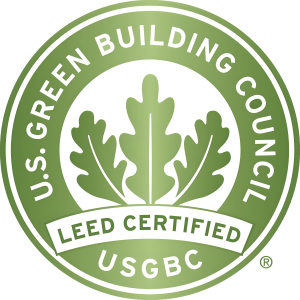Pro tips
Feature image: The LEED Platinum HDR office in Washington, D.C. Photo credit: Halkin Mason Photography/HDR.
Q: As a designer, I am trying to figure out what I can do to make a bigger impact in materials choice and life cycle strategies for my clients’ LEED projects. What would you recommend?
A: For a while now, we have been deep into the conversation about life cycle impact and materials reduction, as well as how those things affect human health. How do materials credits in LEED v4.1 work to make our places more sustainable and healthy for occupants? Sometimes, we have to take a step back first and examine the assumptions we’re making. How can we think differently?
Here are a few ideas:
Use less stuff.
At the start of a LEED project, take a look at the space you are going to design or update. Take an inventory of the materials, furniture and existing structure and determine what you can reuse.
Questions that I ask myself might be whether every floor has to have carpet or resilient flooring. For instance, could you maintain some of the concrete flooring? Other considerations are to work with the manufactures to understand what the end of life for their products really are. Is a given product 100% recyclable or reusable? I often think about the cradle to cradle philosophy—the use of biological nutrients and technical nutrients and avoiding monstrous hybrid products.
Design with flexibility.
It’s possible to design our projects so that deconstructing the building also limits the amount of product sent to landfills. The circular economy is about how we make products that can be reused, donated or recycled in an effort to lessen the embodied carbon in the products over their life cycle.
Embodied carbon is a hot topic these days, and for those who design buildings and interiors, it’s important to be aware that the embodied carbon in the interior space will far exceed the embodied carbon of the initial build. This is because the leases will continue to turn over.
We need to find ways to limit the waste to landfill and instead reuse materials and furniture, recycle materials and integrate demountable walls that can be reused over and over.
Develop a resources library with your manufacturers and vendor reps.
I have done this at several firms where I have worked. The idea is to use the criteria from external sources (such as those in the sidebar below) and only allow products from these sources into your resource library. The point is that designers would not have to worry about the sustainability and health attributes, and you can feel confident that you are making the best choices.
The construction credits for materials can be challenging to achieve. The general contractors are usually providing the documentation. As the designers are selecting materials, be sure to look for products that have EPDs during the design process. Twenty products plus five to seven more is a good number to make sure you get the 2 points. The same is also applicable to finding HPD products. If you can find optimized products, that will also contribute to LEED points. You may also want to explore the pilot credit for circular products.
Another pilot credit that you may be interested in is Social Equity within the Supply Chain. Its intent is to “create more equitable, healthier environments for those affected by and involved in the production of materials and products used in a project, including the stages of raw materials extraction, processing, manufacturing, and assembly of components and products.” For those considering the AIA Framework for Design Excellence, this credit will apply to the pledge statements.
https://www.usgbc.org/articles/pro-tip-using-materials-strategies-leed



